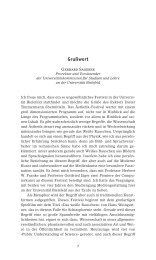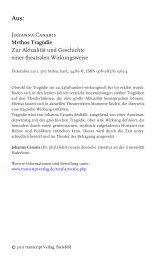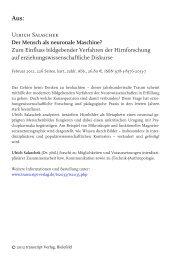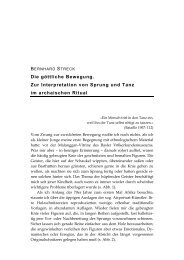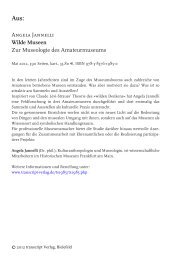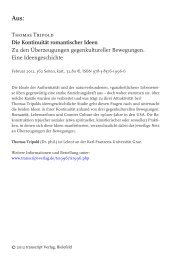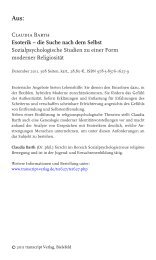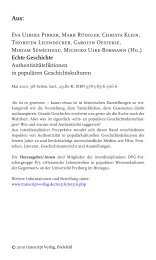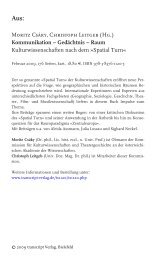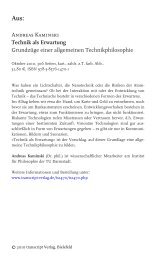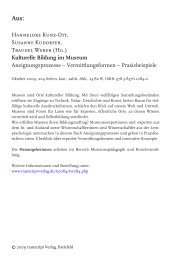Julia Straub (ed.) Paradoxes of Authenticity Studies on a Critical ...
Julia Straub (ed.) Paradoxes of Authenticity Studies on a Critical ...
Julia Straub (ed.) Paradoxes of Authenticity Studies on a Critical ...
Create successful ePaper yourself
Turn your PDF publications into a flip-book with our unique Google optimized e-Paper software.
INTRODUCTION | 23<br />
Loren discusses a number <str<strong>on</strong>g>of</str<strong>on</strong>g> films that reflect the anxiety with which<br />
we face perceiv<str<strong>on</strong>g>ed</str<strong>on</strong>g> threats to our humanist understanding <str<strong>on</strong>g>of</str<strong>on</strong>g> subjectivity.<br />
Narratives <str<strong>on</strong>g>of</str<strong>on</strong>g> artificial intelligence, virtual realities, alien abducti<strong>on</strong><br />
or cyborgian life forms destabilize noti<strong>on</strong>s <str<strong>on</strong>g>of</str<strong>on</strong>g> human identity by bringing<br />
to life the decentrement <str<strong>on</strong>g>of</str<strong>on</strong>g> the subject that we know <strong>on</strong>ly in theory.<br />
What we understand to be authentic in a pers<strong>on</strong> has much to do<br />
with our belief in liberal-humanist and essentialist noti<strong>on</strong>s <str<strong>on</strong>g>of</str<strong>on</strong>g> the self,<br />
which is why these films provoke what Scott calls a “millennial disease”<br />
(161).<br />
The making <str<strong>on</strong>g>of</str<strong>on</strong>g> ‘true’ individual identities within the boundaries <str<strong>on</strong>g>of</str<strong>on</strong>g><br />
a collective identity is what c<strong>on</strong>cerns Uwe Mayer in his essay <strong>on</strong> the<br />
representati<strong>on</strong> <str<strong>on</strong>g>of</str<strong>on</strong>g> football hooliganism in films. Mayer revisits moral<br />
philosophy, whose questi<strong>on</strong>s are: is there something like an authentic<br />
self, a primordial core, which is more original and truer to human nature<br />
than existences cast into roles <str<strong>on</strong>g>of</str<strong>on</strong>g> ‘civiliz<str<strong>on</strong>g>ed</str<strong>on</strong>g>’ behaviour? The individuals<br />
for whom this becomes an issue are English football hooligans,<br />
whose working class existences as dutiful employees, boyfriends<br />
and citizens collide with the liberalizing energies they experience<br />
when engaging in acts <str<strong>on</strong>g>of</str<strong>on</strong>g> violence. Violent fanship is a model <str<strong>on</strong>g>of</str<strong>on</strong>g> social<br />
affiliati<strong>on</strong> which stands in stark c<strong>on</strong>trast to their domesticat<str<strong>on</strong>g>ed</str<strong>on</strong>g> existences<br />
as white working class men, subject to the c<strong>on</strong>sumerist imperatives<br />
<str<strong>on</strong>g>of</str<strong>on</strong>g> Blairite Britain, dull job perspectives and romantic commitments<br />
perceiv<str<strong>on</strong>g>ed</str<strong>on</strong>g> as oppressive. As these films (Philip Davis’s I.D.,<br />
Nick Love’s The Football Factory and Lexi Alexander’s Green<br />
Street) dem<strong>on</strong>strate, being a hooligan means both unleashing and ritualizing<br />
physical violence. This regressi<strong>on</strong> to a pre-civiliz<str<strong>on</strong>g>ed</str<strong>on</strong>g> state unbridl<str<strong>on</strong>g>ed</str<strong>on</strong>g><br />
by laws and internaliz<str<strong>on</strong>g>ed</str<strong>on</strong>g> norms <str<strong>on</strong>g>of</str<strong>on</strong>g> behaviour enables the<br />
young male protag<strong>on</strong>ists <str<strong>on</strong>g>of</str<strong>on</strong>g> these films to explore aspects <str<strong>on</strong>g>of</str<strong>on</strong>g> their pers<strong>on</strong>alities<br />
which are perceiv<str<strong>on</strong>g>ed</str<strong>on</strong>g> as truer than their everyday pers<strong>on</strong>ae.<br />
The ritualistic and formulaic dimensi<strong>on</strong> <str<strong>on</strong>g>of</str<strong>on</strong>g> these identities – the<br />
making <str<strong>on</strong>g>of</str<strong>on</strong>g> which follows certain prescrib<str<strong>on</strong>g>ed</str<strong>on</strong>g> codes, be it the right kind<br />
<str<strong>on</strong>g>of</str<strong>on</strong>g> music or clothing – can be theoriz<str<strong>on</strong>g>ed</str<strong>on</strong>g> in terms <str<strong>on</strong>g>of</str<strong>on</strong>g> performativity.<br />
This is Sabine Nunius’s approach in her essay <strong>on</strong> ‘BrAsian’ identities.<br />
She regards authenticity as the result <str<strong>on</strong>g>of</str<strong>on</strong>g> strategic and highly selfc<strong>on</strong>scious<br />
performative efforts, represent<str<strong>on</strong>g>ed</str<strong>on</strong>g> in novels and music. In the<br />
case <str<strong>on</strong>g>of</str<strong>on</strong>g> Gautam Malkani’s novel L<strong>on</strong>d<strong>on</strong>stani (2006) and the bhangra<br />
music pieces Sabine Nunius discusses, these are British-born Asian



